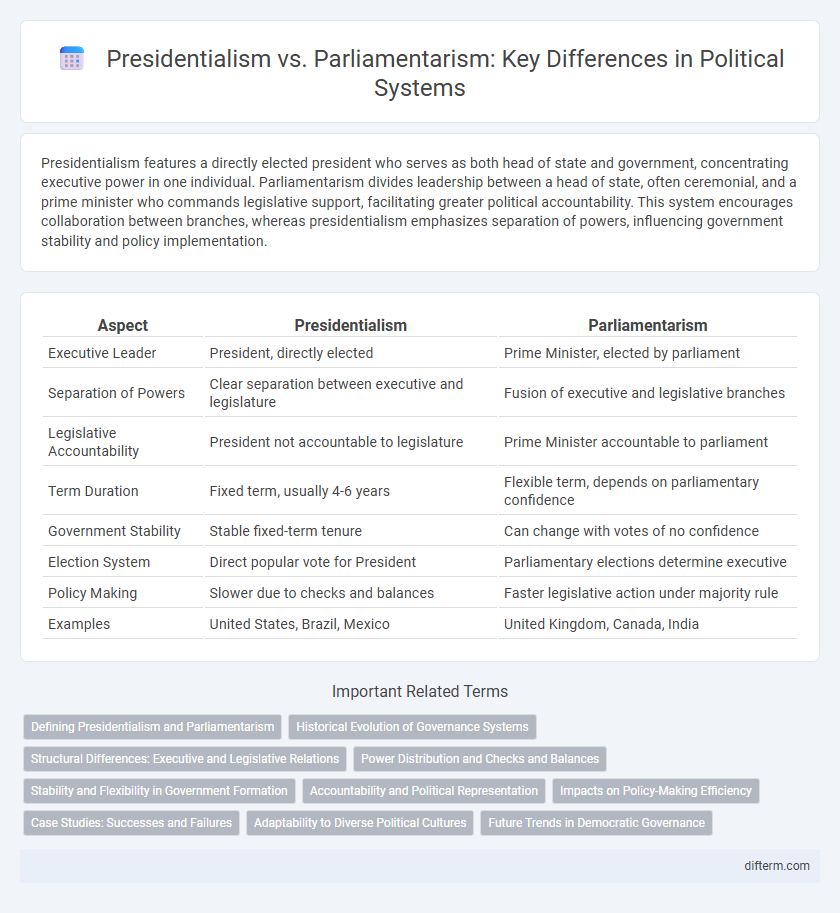Presidentialism features a directly elected president who serves as both head of state and government, concentrating executive power in one individual. Parliamentarism divides leadership between a head of state, often ceremonial, and a prime minister who commands legislative support, facilitating greater political accountability. This system encourages collaboration between branches, whereas presidentialism emphasizes separation of powers, influencing government stability and policy implementation.
Table of Comparison
| Aspect | Presidentialism | Parliamentarism |
|---|---|---|
| Executive Leader | President, directly elected | Prime Minister, elected by parliament |
| Separation of Powers | Clear separation between executive and legislature | Fusion of executive and legislative branches |
| Legislative Accountability | President not accountable to legislature | Prime Minister accountable to parliament |
| Term Duration | Fixed term, usually 4-6 years | Flexible term, depends on parliamentary confidence |
| Government Stability | Stable fixed-term tenure | Can change with votes of no confidence |
| Election System | Direct popular vote for President | Parliamentary elections determine executive |
| Policy Making | Slower due to checks and balances | Faster legislative action under majority rule |
| Examples | United States, Brazil, Mexico | United Kingdom, Canada, India |
Defining Presidentialism and Parliamentarism
Presidentialism features a head of state who is also the head of government, elected independently from the legislature, allowing for a clear separation of powers and fixed terms. Parliamentarism combines the roles of head of government with the prime minister, who is chosen by the legislature and can be dismissed through a vote of no confidence, fostering interdependent executive-legislative relations. This fundamental structural difference influences political stability, accountability, and government responsiveness in democratic systems worldwide.
Historical Evolution of Governance Systems
Presidentialism and parliamentarism evolved through centuries of political experimentation, significantly shaped by the Enlightenment and revolutions such as the American and French Revolutions, which emphasized separation of powers and representative democracy. The historical shift from monarchies to constitutional governments introduced the divergence between presidential systems, characterized by a separately elected executive, and parliamentary systems, where executive power derives from the legislative majority. Key developments include the 18th-century U.S. Constitution establishing presidentialism and the British adaptation of parliamentary sovereignty, reflecting distinct approaches to balancing authority and accountability in modern governance.
Structural Differences: Executive and Legislative Relations
Presidentialism features a clear separation of powers where the president, elected independently, holds executive authority separate from the legislature, providing direct accountability to voters. Parliamentarism merges executive and legislative functions, with the prime minister and cabinet drawn from the parliamentary majority, ensuring executive dependence on legislative support. This structural difference influences political stability, government accountability, and policy-making efficiency through varying mechanisms of checks and balances.
Power Distribution and Checks and Balances
Presidentialism centralizes executive power in a directly elected president, creating a clear separation of powers between the executive and legislature, which can limit legislative influence but may reduce government responsiveness. Parliamentarism features a fusion of executive and legislative branches, where the prime minister depends on parliamentary support, enabling more fluid policy-making but potentially concentrating power within the ruling party. Checks and balances in presidential systems rely on constitutional mechanisms such as vetoes and impeachment, while parliamentary systems depend on votes of confidence and coalition-building to maintain executive accountability.
Stability and Flexibility in Government Formation
Presidentialism offers stability through fixed terms and a clear separation of powers, which reduces the risk of frequent government collapses. Parliamentarism provides greater flexibility in government formation by allowing coalitions and votes of confidence to promptly respond to shifting political dynamics. This adaptability often enables parliamentary systems to better manage political crises and maintain executive accountability.
Accountability and Political Representation
Presidentialism centralizes executive power in a directly elected president, which can enhance accountability by clearly assigning responsibility for policy outcomes to a single individual. Parliamentarism fosters political representation through the integration of executive and legislative branches, allowing for collective decision-making and responsiveness to diverse political parties. This system can complicate accountability due to the diffusion of power but often promotes broader representation and coalition governance.
Impacts on Policy-Making Efficiency
Presidentialism often leads to slower policy-making due to fixed terms and separation of powers, which can create gridlock between the executive and legislature. Parliamentary systems tend to enhance policy efficiency through greater executive-legislative integration, allowing for faster legislative approval and streamlined decision-making. Empirical studies show that countries with parliamentary regimes generally pass more legislation and implement policies more swiftly than those with presidential systems.
Case Studies: Successes and Failures
Case studies reveal that presidentialism often faces challenges like executive-legislative gridlock, exemplified by Venezuela's political instability, while parliamentarism tends to provide greater policy coherence as seen in the United Kingdom's effective coalition governments. Brazil's presidential system highlights difficulties in governance due to divided government, whereas Germany's parliamentary system demonstrates success through constructive vote of no confidence and coalition-building mechanisms. The comparative analysis underscores that institutional design and political context crucially influence the efficacy of presidential and parliamentary systems worldwide.
Adaptability to Diverse Political Cultures
Presidentialism often faces challenges in countries with fragmented political cultures due to its fixed executive authority and potential for rigid power distribution. Parliamentarism tends to offer greater adaptability by allowing coalition governments and more flexible legislative-executive relations, which can better accommodate diverse political interests. Countries with pluralistic or multiethnic societies frequently adopt parliamentary systems to enhance political stability and representation.
Future Trends in Democratic Governance
Future trends in democratic governance indicate a renewed interest in hybrid systems blending presidentialism and parliamentarism to enhance executive-legislative cooperation. Innovations such as semi-presidential models and flexible coalition-building mechanisms aim to balance stability with responsiveness in governance. Emerging democracies increasingly experiment with these frameworks to address challenges like political polarization and governance gridlock.
presidentialism vs parliamentarism Infographic

 difterm.com
difterm.com